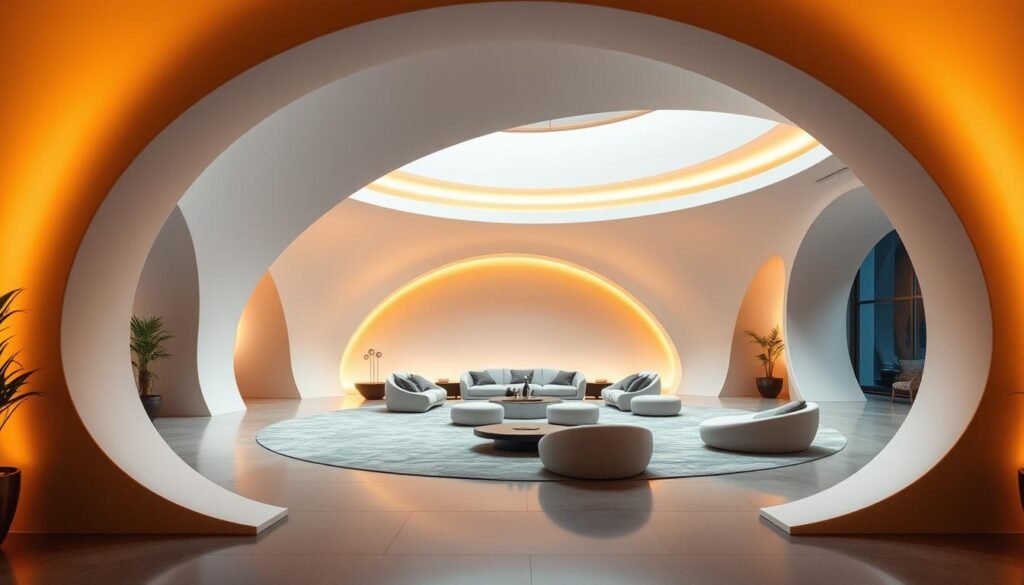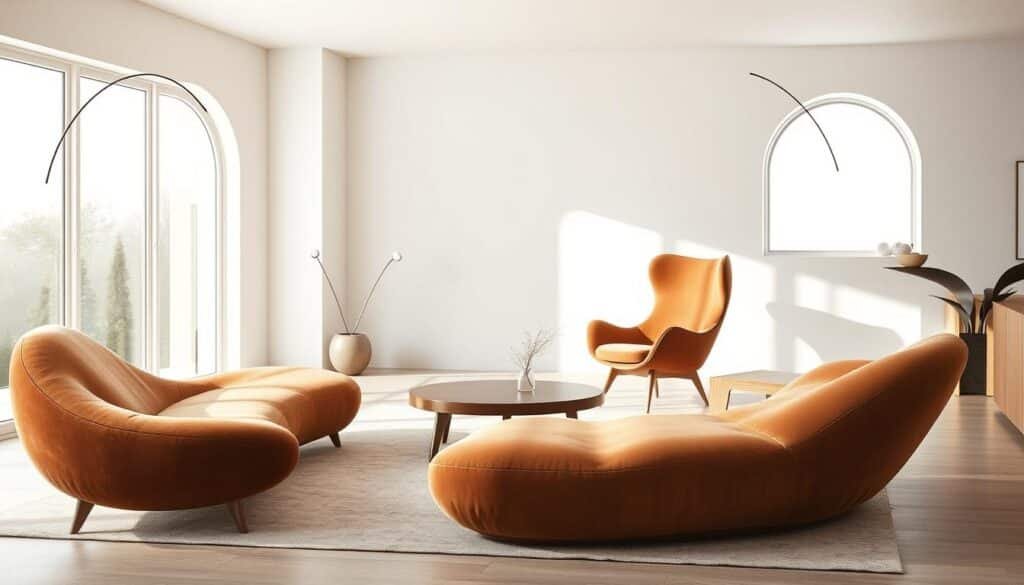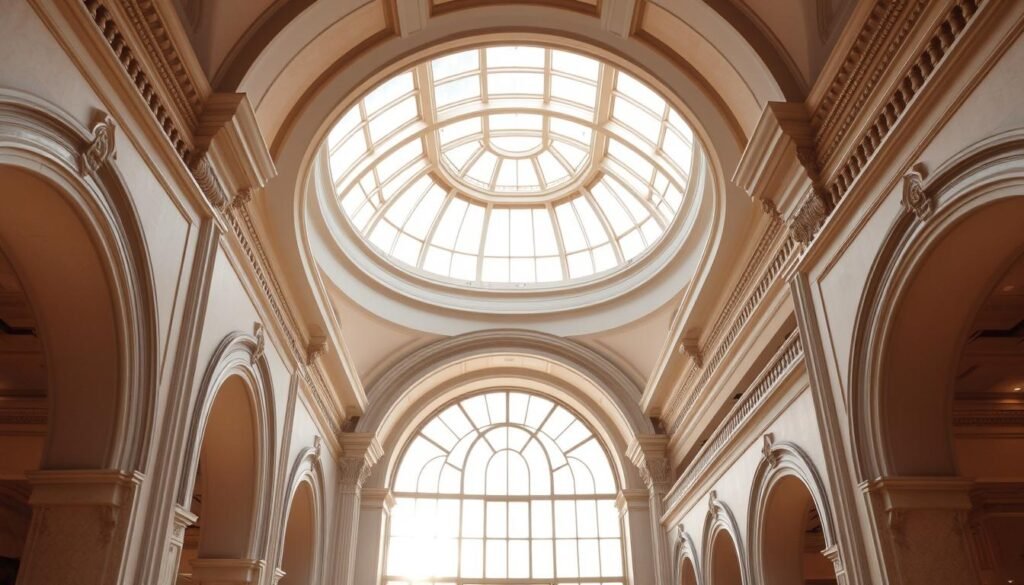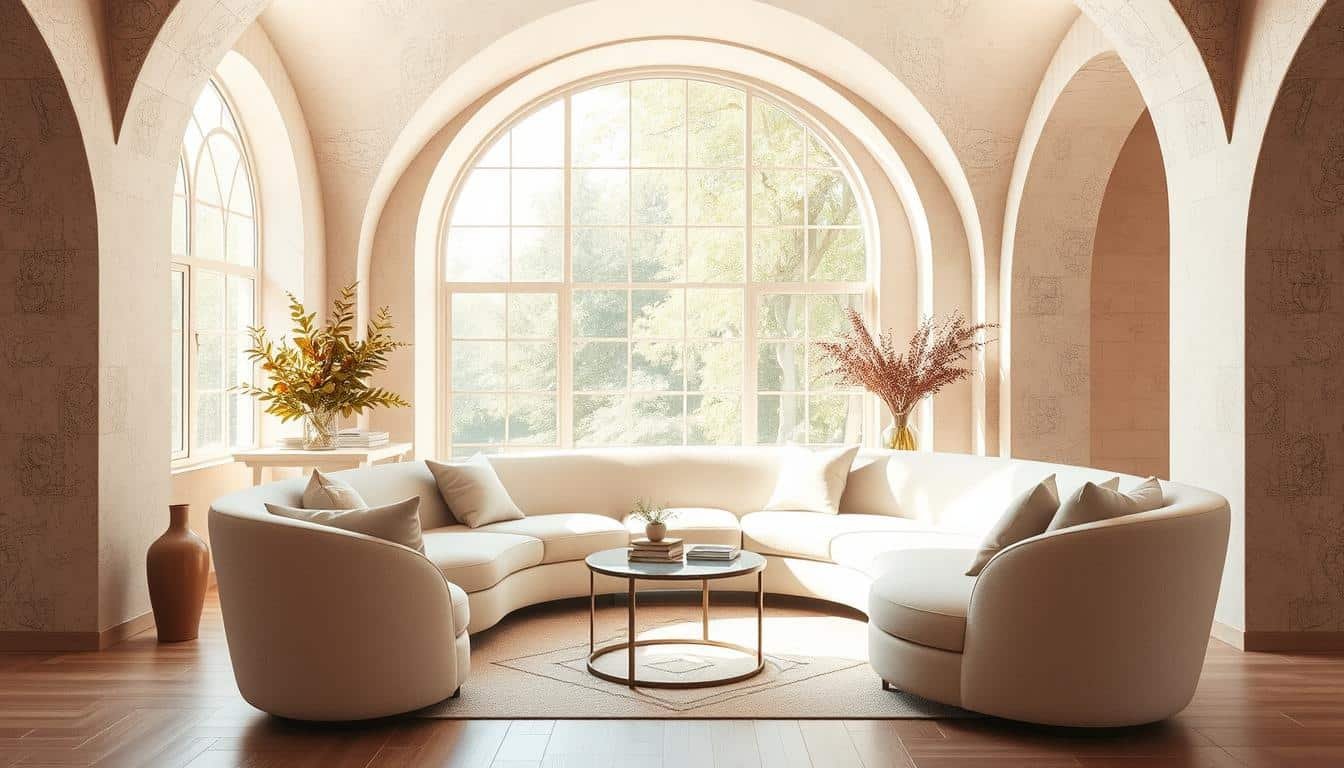This post may contain affiliate links. When you purchase through links on our site, we may earn an affiliate commission.
Why do we instinctively gravitate toward rounded shapes in our living spaces? Through years of reshaping interiors, I’ve found that organic forms create environments where people naturally relax and connect. While crisp angles dominate modern construction, our biological wiring still responds to the soft contours found in natural landscapes.
Historic visionaries understood this secret long before ergonomic studies confirmed it. Antoni Gaudí’s flowing stonework and Eero Saarinen’s iconic tulip chairs prove curved designs transcend trends. These creations don’t just look inviting – they feel inviting, guiding movement and sightlines in ways boxy structures can’t match.
My design philosophy treats every arch and bend as a functional tool. A rounded room divider eases foot traffic better than sharp corners. A sinuous sofa arrangement encourages face-to-face conversations. Even subtle curves in shelving units can make compact spaces breathe easier.
Key Takeaways
- Organic shapes boost comfort by mirroring natural patterns we find soothing
- Historical designs from Art Nouveau to Mid-Century Modern demonstrate lasting curved form success
- Fluid architectural features improve spatial flow and social interaction
- Rounded furnishings solve common layout challenges while adding visual warmth
- Balanced curvature creates focal points without overwhelming modern aesthetics
Embracing the Curved Aesthetic in Modern Design
The secret to timeless interiors might be hidden in nature’s blueprint. For over a century, visionaries have translated Earth’s contours into living spaces that feel both fresh and familiar. This dialogue between organic inspiration and human creativity continues shaping how we inhabit modern environments.
Historical Influences and Evolution
My studies of Art Nouveau reveal how pioneers like Gaudí treated every arch as a revolution. They didn’t just build structures – they crafted ecosystems where stone flowed like water. Mid-century designers later refined this approach: Aalto’s undulating wood surfaces and Saarinen’s pedestal chairs turned functional items into sculptural design statements.
Modern Interpretations and Subtle Elegance
Today’s innovators approach fluid shapes with restraint. Brands like LINTELOO hide gentle arcs in cabinet edges and chair legs, creating discovery moments rather than obvious statements. These whispered curves guide movement through rooms while maintaining minimalist appeal, transforming strict layouts into social catalysts without demanding attention.
Incorporate curved and arched elements in furniture and architecture
The human body isn’t made of straight lines, so why should our surroundings be? My approach to spatial harmony begins with this simple truth. Organic patterns mirroring nature’s rhythms create interiors where people instinctively feel at home.
Defining Organic and Curve Design
To me, organic design means creating dialogue between built environments and natural landscapes. It’s not about literal leaf motifs, but rather capturing the essence of wind-sculpted dunes or river-smoothed stones. These principles transform rigid rooms into living ecosystems.
Curve-focused layouts solve practical challenges while whispering elegance. A crescent-shaped sofa I recently styled eliminated awkward corners in a narrow loft. The owners reported unexpected benefits – guests naturally faced each other, sparking deeper conversations.
Visual and Functional Benefits
Fluid silhouettes work magic in compact areas. Rounded bookshelves I installed in a studio apartment created breathing room where boxy units felt oppressive. The secret? Gentle arcs trick the eye into perceiving more negative space.
Comfort gains prove equally remarkable. Unlike angular chairs that fight our posture, contoured seating supports spinal curves naturally. One client described her new lounge chair as “a hug that improves my back pain.”
These forms also guide movement through rooms like invisible conductors. A curved hallway in a recent renovation project eliminated the sterile feel of traditional corridors. Visitors now pause to admire shifting sightlines rather than rushing to destinations.
Design Fundamentals: Curves, Movement, and Interior Flow
Every step through a room tells a story shaped by its contours. In my work, I treat flowing design lines as silent guides that choreograph how people interact with space. Unlike angular layouts that command rigid movement, gentle arcs create natural pathways our bodies recognize from nature’s playbook.

Creating a Harmonious Space
I start by mapping how eyes and feet travel through a room. Curved shelves in a recent project redirected focus toward bay windows, while a rounded console table eliminated hallway congestion. These tweaks transformed disjointed areas into cohesive zones.
Sight lines make or break spatial flow. A softly arched doorway I designed frames views between kitchen and living areas, encouraging connection without visual clutter. Clients often remark how these features feel intuitive – like the space anticipated their needs.
Traffic patterns benefit most from curved solutions. Sharp corners create hesitation points; flowing walls erase them. In a compact apartment redesign, eliminating right angles increased usable floor area by 18% – all through strategic curvature.
True harmony emerges when form and function dance. I balance active movement zones with curved seating nooks that invite pause. This rhythm mirrors nature’s balance between streams and resting pools, creating interiors that energize and soothe in equal measure.
Inspiration from Renowned Designers and Curved Furniture Trends
What separates memorable interiors from fleeting trends? Often, it’s the invisible hand of master creators. I’ve discovered that studying visionary designers offers a blueprint for blending artistry with livability. Their work proves fluid forms can shape behavior as much as aesthetics.

Case Studies from LINTELOO and Iconic Designers
LINTELOO’s ‘Embrace’ collection reshapes how we experience daily rituals. Anthony Guerrée’s dining chair cradles users with seamless curves, while his Cross table merges marble and oak into a sculptural centerpiece. These pieces don’t just fill space – they choreograph movement.
Sebastian Herkner’s Gilbert bed taught me geometry and warmth aren’t enemies. Its cubist frame appears weightless yet sturdy, a lesson in visual balance. Jan te Lintelo’s Miami sofa demonstrates how rounded edges foster connection – guests instinctively cluster on its welcoming crescent.
Curved Furniture Projects Shaping Today’s Trends
Modern projects prioritize adaptability. Yabu Pushelberg’s Oiseau series floats through rooms with feather-light profiles, proving curves work equally well in dining chairs and counter stools. Custom upholstery options let these designs morph to suit any interior personality.
Sjoerd Vroonland’s Clamp series reveals the beauty of construction. Visible metal staples celebrate craftsmanship while securing curved wood and marble elements. It’s a reminder that how furniture comes together matters as much as its final form.
These innovators share a common thread: they create pieces that invite touch and interaction. Whether through a chair’s embracing silhouette or a table’s flowing base, their design choices spark natural human connections – the true mark of timeless work.
Incorporating Curved Elements into Architecture and Interiors
True innovation in design often hides in plain sight. My work focuses on transforming overlooked structural components into functional art that elevates daily living. Strategic curvature in permanent features creates rhythm within spaces, guiding both light and movement with natural grace.

Innovative Applications in Feature Walls, Ceilings, and Built-ins
Curved walls became my secret weapon for awkward entryways. In a recent renovation, a sweeping plaster wall transformed a cramped foyer into a welcoming prelude to the home. The owners reported guests lingering to admire the sculptural effect rather than rushing past.
Ceiling treatments offer untapped potential. A barrel-vaulted design I implemented in a ranch house added 18% more perceived height. Coved edges where walls meet ceilings soften harsh angles, creating cloud-like transitions that diffuse light beautifully.
| Element | Key Benefit | Best Application |
|---|---|---|
| Barrel-Vaulted Ceiling | Creates spacious feel | Living rooms |
| Coved Transitions | Softens harsh angles | Bedrooms |
| Arched Windows | Enhances natural light | Dining areas |
| Spiral Staircases | Saves floor space | Urban lofts |
Built-ins prove curves needn’t sacrifice utility. A client’s narrow library gained breathing room with rounded shelving that followed the wall’s natural curve. The design added 12% more storage while eliminating claustrophobic corners.
Windows became my canvas in a coastal project. Half-moon transoms above doorways framed ocean views like living paintings. These architectural features transformed ordinary openings into curated moments celebrating the landscape.
Conclusion
Our attraction to flowing forms runs deeper than aesthetics – it’s etched into our DNA. Through my work, I’ve seen how curved design reshapes relationships between people and their environments. These organic patterns don’t just decorate space – they awaken our innate need for comfort and connection.
What continues to surprise me is curves’ dual power as aesthetic enhancers and functional problem-solvers. A single arched doorway can soften harsh lighting while guiding foot traffic. Rounded seating arrangements I’ve designed often become conversation hubs, proving geometry influences social dynamics.
The magic lies in balance. Dramatic curved ceilings make bold statements, while subtle bends in shelving units add quiet rhythm. This interplay creates interiors that feel both exciting and familiar – spaces where eyes glide effortlessly from one feature to another.
Looking ahead, I see interior design embracing these principles even more strongly. As we prioritize mental well-being, spaces mimicking nature’s flow will dominate. My philosophy remains simple: when rooms echo life’s organic patterns, they don’t just house us – they nurture us.

 using WordPress and
using WordPress and 
No responses yet